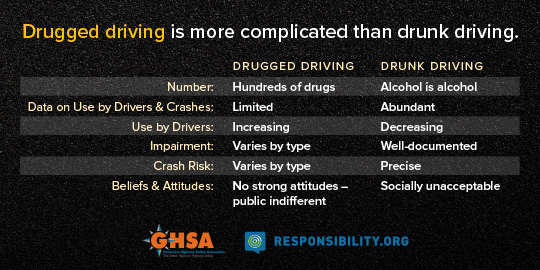Driving Under the Influence of Drugs, be they prescription, illegal, or marijuana, now accounts for 40 percent of driver fatalities, about the same as alcohol-related deaths, according to a new report from the Governors Highway Safety Association.
"A quadrupling in the use of prescription drugs since 1999, and legalization of marijuana use in some states are cited among the reasons drug use has become an increasing threat to roadway safety," writes of The Washington Post.

Credit: Governors Highway Safety Association (GHSA)
The number of dead drivers who tested positive for drugs has increased from 29 percent in 2005 to 39.9 percent in 2013, the report said, citing federal crash data.
The report from the GHSA, an "organization of state highway safety officers," draws on data from the Fatality Analysis Reporting System (FARS) supplied by the National Highway Traffic Safety Administration (NHTSA), a division of the U.S. Department of Transportation.
“We look to the federal government to take a leadership role in this issue similar to that of drunk driving and seat-belt use,” said Jonathan Adkins, executive director of the Governors Highway Safety Association.
"Marijuana is legal in some form in 23 states and the District of Columbia, while other states are considering legalization," writes Halsey III. "Driving under the influence of marijuana is illegal in all states."
“Every state must take steps to reduce drug-impaired driving, regardless of the legal status of marijuana,” Adkins said. “We encourage NHTSA to issue guidance on best practices to prevent marijuana-impaired driving.”
The report acknowledges that three other studies "differed somewhat in linking marijuana law changes to traffic fatalities," adds Ashley III.
One found that was there an increased marijuana presence in fatally injured drivers in only three of 14 states studied. Another focusing on Colorado said that marijuana-positive fatalities increased by about 4 percent. The third, in California, found no change after marijuana was decriminalized there in 2011.
Funding for the report was provided by the Foundation for Advancing Alcohol Responsibility (Responsibility.org).
FULL STORY: Drug use now rivals drunk driving as cause of fatal car crashes, study says

Alabama: Trump Terminates Settlements for Black Communities Harmed By Raw Sewage
Trump deemed the landmark civil rights agreement “illegal DEI and environmental justice policy.”

Planetizen Federal Action Tracker
A weekly monitor of how Trump’s orders and actions are impacting planners and planning in America.

Why Should We Subsidize Public Transportation?
Many public transit agencies face financial stress due to rising costs, declining fare revenue, and declining subsidies. Transit advocates must provide a strong business case for increasing public transit funding.

Understanding Road Diets
An explainer from Momentum highlights the advantages of reducing vehicle lanes in favor of more bike, transit, and pedestrian infrastructure.

New California Law Regulates Warehouse Pollution
A new law tightens building and emissions regulations for large distribution warehouses to mitigate air pollution and traffic in surrounding communities.

Phoenix Announces Opening Date for Light Rail Extension
The South Central extension will connect South Phoenix to downtown and other major hubs starting on June 7.
Urban Design for Planners 1: Software Tools
This six-course series explores essential urban design concepts using open source software and equips planners with the tools they need to participate fully in the urban design process.
Planning for Universal Design
Learn the tools for implementing Universal Design in planning regulations.
Caltrans
Smith Gee Studio
Institute for Housing and Urban Development Studies (IHS)
City of Grandview
Harvard GSD Executive Education
Toledo-Lucas County Plan Commissions
Salt Lake City
NYU Wagner Graduate School of Public Service



























